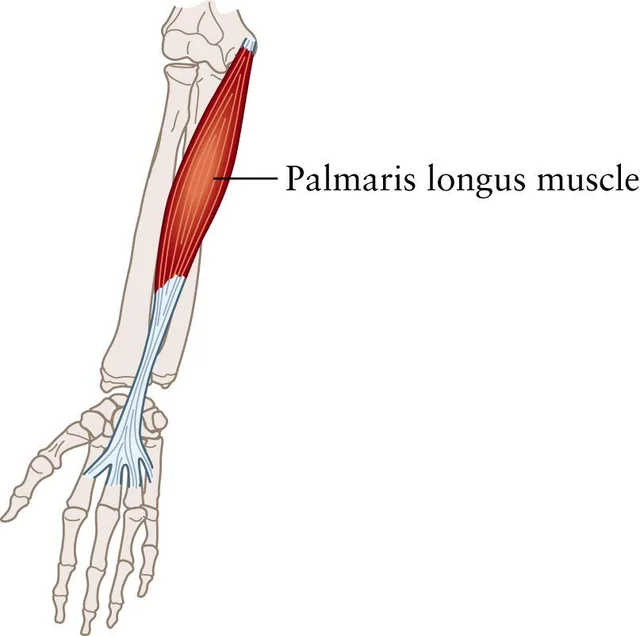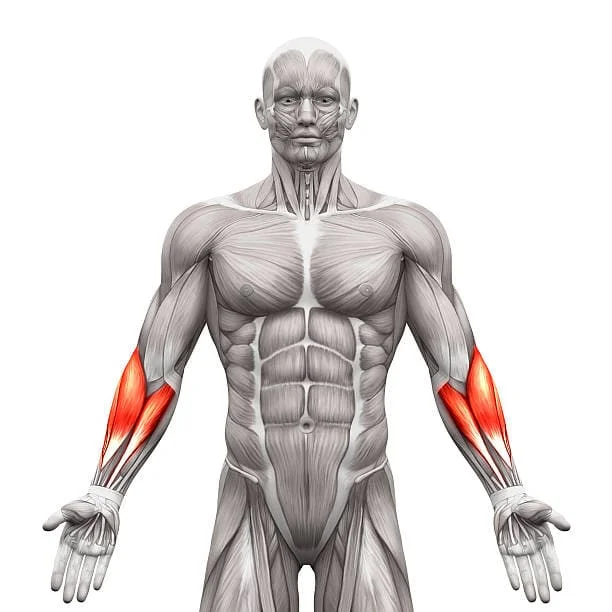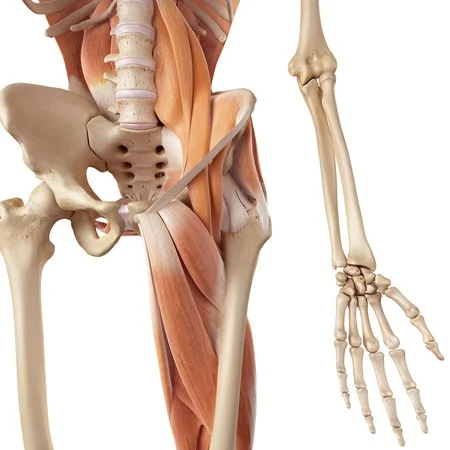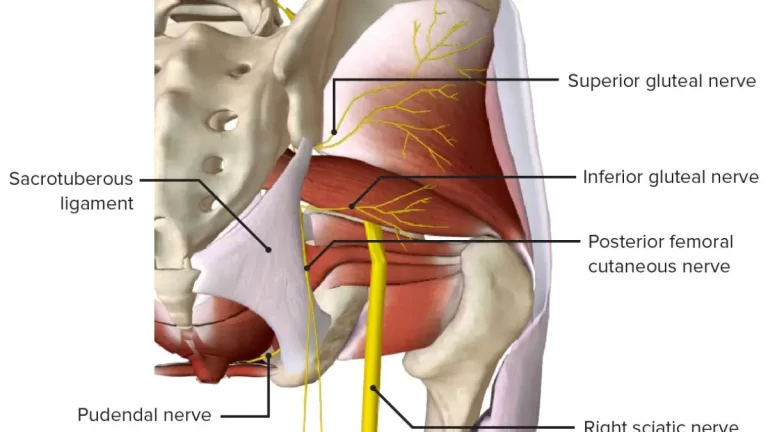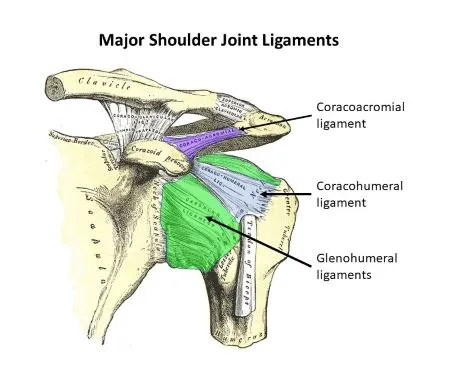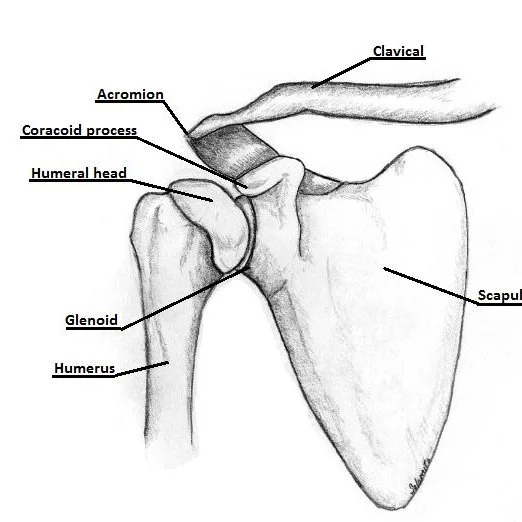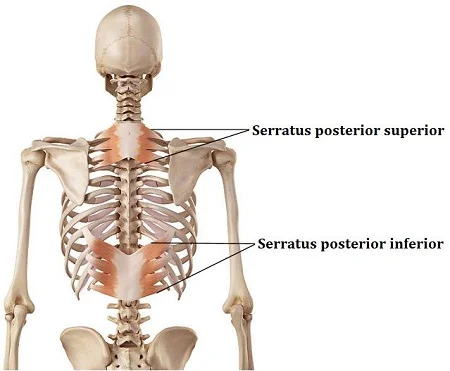Palmaris Longus Muscle
What Is The Palmaris Longus Muscle?
The Palmaris Longus muscle is a slender, superficial muscle located in the forearm. It is one of the muscles belonging to the superficial flexor group and plays a minimal role in wrist flexion.
This muscle is a member of the superficial forearm flexor group. Its most common proximal attachment is made to the muscle via the common forearm flexor tendon at the medial epicondyle of the humerus. Its most common distal attachment is made to the connective tissue fibers of the palmar muscle and the flexor retinaculum, it is a ligamentous structure that supports the median nerve and digital flexor and forms the height of the carpal tunnel.
Although the shape of the palmaris longus can vary greatly, it typically consists of a long, thin tendinous part at the distal end, a mid-length, spindle-shaped muscular belly, and a tendinous proximal connection. The palmaris longus tendon broadens into a flattened bundle of fibers, most of which pass superficially to the flexor retinaculum. The fibers then interweave with the palmar aponeurosis.
While the palmaris longus may not seem like much in everyday life, it is therapeutically significant due to its frequent preoperative collection throughout some surgical operations, such as the revision of the upper extremity tendon. The muscle’s small distal tendinous part, superficial location, and lack of functional significance make it ideal for intraoperative collection for tendon reconstruction and other surgical procedures.
Depending on the population under study, the palmaris longus muscle may be absent in 2.5% to 26% of people however being typically present in most people. The palmaris longus tendon is positioned lateral to the flexor carpi ulnaris tendon and medial to the flexor carpi radialis tendon, close to the anatomical center of the anterior wrist.
Clinical assessment of the muscle’s presence can be done using a variety of physical exam actions the most popular of which is the Schaeffer test. When the patient flexes their wrist and touches the pads of their thumb and little finger together, the tendon of the palmaris longus should extend anteriorly at the wrist joint, indicating the presence of the Schaeffer test. Although it has been shown to cause reduced grip strength or any other functional deficiency, congenital absence of the muscle is common.
Structure
The proximal medial side of the flexor carpi radialis is home to the spindle-shaped, thin, extended muscle known as palmaris longus. The distal attachments are where it is the smallest, while the middle is where it is the largest.
It originates mostly from the humerus’s medial epicondyle through the common flexor tendon. It also comes from the antebrachial fascia and the close intermuscular divides.
The tendon ends in a thin, pushed tendon that enters the middle region of the flexor retinaculum and traverses the top section of the palmar aponeurosis. It frequently results in a tendinous movement in the short muscles of the thumb.
Function
Together with the palmaris longus, the flexor carpi radialis and ulnaris muscles support balanced hand flexion on the wrist. Since the other forearm muscles attach to the humerus and cross the elbow joint when completely extended, it stabilizes the elbow joint.
This fascial sheath is fixed during the muscle withdrawal by strands that attach to the palmar aponeurosis. This causes a weak flexion of the second to fifth metacarpophalangeal joints as the aponeurosis is drawn towards the wrist. The tightening of the palmar aponeurosis aids in keeping the hand’s hold on specific items.
As the muscle decreases, the fascial sheath around the palmar muscles tightens, pulling the muscles toward the wrist and causing a mild flexion of the second to fifth metacarpophalangeal joints. Maintaining the hand’s grip on some objects is also assisted by the palmar aponeurosis tightening.
Tensioning of the palmar aponeurosis
- The palmaris longus muscle also helps to tension the palmar aponeurosis, which is a broad sheet of connective tissue that covers the palm.
- This tensioning action is important for maintaining the integrity of the palmar aponeurosis during hand movements.
- While the palmaris longus muscle’s function is relatively minor compared to other muscles in the forearm, its absence is not usually noticeable, as other muscles can compensate for its function.
- In some cases, the palmaris longus muscle may be used as a source of tendon grafts for reconstructive surgery or tendon transfers.
Origin
The origin of the palmaris longus muscle is the humerus’s medial epicondyle.
Insertion
The tendon enters the hand’s palmar surface by passing through the flexor retinaculum superficially, or externally. While some tendinous fibers extend out and proceed distally and eventually place into the palmar aponeurosis, others blend in with the superior surface of the retinaculum.
Nerve supply
The palmaris longus muscle is innervated by the proximal nerve roots C5–T1 located in the branches of the median nerve. In addition to the loss of sensory function in the median nerve’s distribution, injuries to the median nerve at or above the elbow joint can cause a deficiency in the palmaris longus and other forearm flexor muscles, resulting in weakened elbow flexion, wrist flexion, radial deviation, finger flexion, thumb opposition, flexion, and abduction.
Blood Supply
The human upper extremity’s ulnar artery, a branch of the brachial artery, provides blood to the palmaris longus muscle. The upper extremity’s basilic and cephalic veins carry blood out of the muscle. Ischemia of the palmaris longus and other forearm flexor muscles can result from compartment syndrome, compromised venous outflow, and compromised arterial blood supply.
Ulnar artery
- The ulnar artery is a branch of the brachial artery, which is the main artery in the upper arm.
- The ulnar artery runs down the medial side of the forearm and gives off several branches, including the anterior ulnar recurrent artery and the common interosseous artery.
- These arteries supply blood to the medial aspect of the palmaris longus muscle.
Radial artery
- The radial artery is another major branch of the brachial artery.
- It runs down the lateral side of the forearm and gives off several branches, including the radial recurrent artery and the posterior interosseous artery.
- These arteries supply blood to the lateral aspect of the palmaris longus muscle.
- The arterial supply to the palmaris longus muscle is important for its nutrition and oxygenation, which is necessary for proper muscle function and healing after injury or surgery.
Lymphatic Drainage
A unilateral wrist joint deformity known as permanent ischemic Volkmann flexion contracture can result from a prolonged decrease in the effective artery supply or venous drainage.
Embryology
Dermatome and myotome complexes are formed when they compress. Myoblasts are produced when a protein moves into the growing limb buds. Muscles are divided into groups according to the process of limb buds extending and muscle cells developing muscle.
For example, the palmaris longus is a part of the forearm flexor group. The embryologic reasons for congenital unilateral or bilateral absence of the palmaris longus in humans have not been studied.
Anatomical Variation
The palmaris longus is one of the most unstable muscles in the human body. The palmaris longus can have a symmetric or asymmetric shape in bodies, displaying common and uncommon anatomical variations. Among the most frequently reported atypical shapes are duplicate muscles, split tendons, digastric muscle bellies, unilateral and bilateral congenital absence, and various distal insertions.
Examples of distal insertions that are commonly reported include the palmar aponeurosis, flexor retinaculum, forearm fascia, hypothenar muscles/fascia, abductor pollicis brevis, metacarpophalangeal joints, tendon of flexor carpi ulnaris, and the pisiform and scaphoid bones.
Large-scale research has revealed variations in the structural power by gender, with absence being more common in women, and as high as 26.6% of the population having both unilateral and bilateral congenital absence, with bilateral absence being more common. The muscle may Divided into three segments with different tendinous insertion points control.
Surgical Considerations
The palmaris longus tendon is frequently collected for autogenous tendon grafting and other surgical procedures because of its length, superficial location, ease of access in the upper extremities, limited action as a wrist flexor, and lack of functional damage in the wrist and forearm function after collection.
For treatments like digital flexor and extensor tendon repair, flexor pollicis longus repair, chronic mallet finger repair, severe carpal tunnel syndrome, and carpometacarpal joint arthroplasty, surgeons can collect the palmaris longus tendon.
Clinical Significance
Clinical manifestations resembling carpal or Guyon canal compression occasionally result from abnormal or normal anatomy of the palmaris longus muscles compressing the median and ulnar nerves. Forearm soft tissue tumors may be mistaken for the muscle. In some cases, but not rarely, abnormalities in the palmaris longus muscles may compress the ulnar artery or other related tissues.
Surgeons place particular importance on the Palmaris Longus tendon because it is commonly employed as a tendon transplant in procedures involving the repair and transfer of upper limb tendon. Because it is an auxiliary muscle and its absence has not been linked to any functional loss of grip or pinch strength, this muscle is perfect for usage during surgical operations.
The Palmaris longus tendon, which is 12–15 centimeters long, has been utilized to treat claw-finger abnormalities. The Palmaris longus tendon was commonly used to treat hand abnormalities associated with leprosy. Radial palsy and opponensplasty have also been treated with the Palmaris longus tendon. The Palmaris longus muscle can substitute paralyzed lumbricals due to its strength.
The Palmaris longus is appropriate for the previously described therapies because of the following traits:
The palmaris longus muscle is less bulky than the lumbrical muscle and has a mechanical advantage because it is directly in the line of needed pull.
It is easy to analyze because it is superficial.
As it passes through soft tissues, it stays away from aligning with stationary structures.
The muscle can be preserved without leading to a notable deficiency.
Other Issues
Because the palmaris longus muscle is superficial, surgeons frequently collect it for tendon transplantation. Preoperative ultrasonography screening helps minimize the rare problem of accidental median nerve collecting.
Clinical Examinations To Determine When The Muscle
Over time, experts across the planet have developed a few clinical exams to identify the Palmaris Longus muscle in particular. Simply holding the wrist and hand in certain positions is all that is required for these tests to put the muscle under tension and make the tendon visible and feelable. However, there are differences between the tests in terms of validity and reliability.
Standard Test – Schaeffer’s Test
The original exam was created in 1909.
This involves keeping a 90-degree angle with the forearm and using the thumb to oppose the little finger while moving the wrist only slightly.
Thompson’s Test
The maneuver is clenching the testing hand into a fist, then flexing the wrist against the resistance while keeping the thumb bent over the remaining fingers.
Mishra’s Test
Involves both passive hyperextension of the metacarpophalangeal joints and slightly active wrist flexion.
Gangata’s Test
The first position for testing is thumb abduction. The individual is then told to resist abduction of the thumb and flexion of the wrist.
“Two Finger Sign” – Pushpakumar’s Test
The first digit, the fourth, and the fifth must all be fully extended by participants. Additionally, the numbers two and three must be fully expanded.
“Four Finger Sign”
Combines the complete extension of the second to fifth digits with forceful introduction and pronation of the thumb at the first MCP.
Exercises of Palmaris Longus Muscle
Stretching Exercise of Palmaris Longus Muscle
Palmaris Longus Stretch
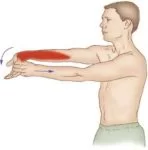
- Hold your right arm straight out in front of you to stretch your wrist flexors.
- Your hands should be held with the palms facing out.
- Raise your left hand, take hold of your right hand’s fingers, and bend them back.
- You should be able to feel your right forearm getting stretched.
- For ten to fifteen seconds, hold the stretch; repeat as necessary.
Wrist extension/flexion stretch
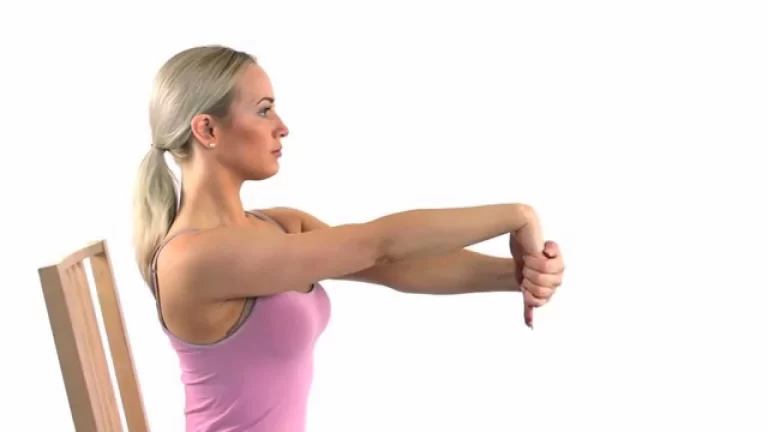
- Stretch your arm out in front of you, palm down.
- Feel the stretch in your forearm as you slowly draw your fingers back toward your wrist with your other hand.
- After 20 to 30 seconds of holding, release.
- Use the other arm to perform the same movement.
Strengthening Exercise of Palmaris Longus Muscle
Towel Wring

- Make sure the towel is wet by soaking it in water.
- The towel should be rolled up into a cylinder. hold the towel with both hands, starting with an overhand hold.
- Twisting the towel will remove the excess. Twist the towel with your left hand pointing in your direction and your right hand pointing outward.
- Finish the activity and alternate directions for thirty seconds. Finish all three sets, pausing in between.
Wrist curls
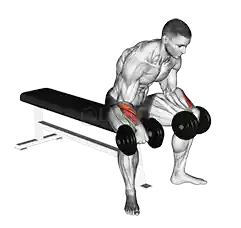
- Place your forearm on a table or bench, dangling your wrist over the edge, and grasp a light dumbbell or resistance band with your palm facing up.
- Bending your wrist upward, gradually lift the weight and lower it back down.
- Perform ten to fifteen repetitions in two or three sets.
Reverse forearm curls
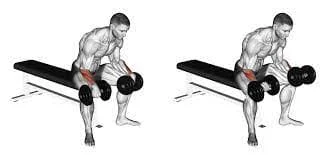
- Hold a weight plate or dumbbell with your palm facing downward.
- With your wrist hanging over the side, place your forearm on a table or bench.
- Curl the weight slowly upward and then back down.
- Perform ten to fifteen repetitions in two or three sets.
Wrist extension
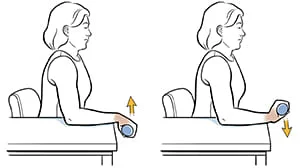
- With the palm of your hand facing down, hold a lightweight.
- With your wrist hanging over the side, place your forearm on a table or bench.
- Bending your wrist upward, gradually lift the weight and bring it back down.
- Perform ten to fifteen repetitions in two or three sets.
Wrist flexion
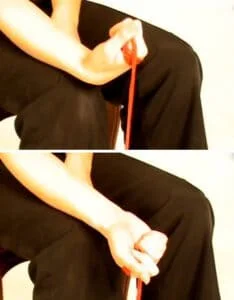
- Your palm should be facing up when you hold a lightweight in the palm of your hand.
- With your wrist hanging over the side, place your forearm on a table or bench.
- Bending your wrist downward, gradually raise the weight and lower it again.
- Perform ten to fifteen repetitions in two or three sets.
Barbell wrist flexor roller
- A kettlebell, a racked barbell, and a sturdy band are needed for this workout.
- Start by wrapping one end of the strength band around the shoulder-level sleeve of a hand weight. Feed the band’s longer end through the handle’s loop and around the bulb to attach the kettlebell.
- Hold the barbell cuff with your palms facing down while standing behind it. To lift the kettlebell off the ground and flex your wrists, rotate the barbell cuff away from your body. When the portable weight reaches its highest point, loosen your grip just a little bit to let it fall to the ground.
- During this period, be very aware of where your feet are placed. Alternatively, you might roll the barbell cuff forward with your wrists to gradually reduce the weight.
Banded wrist curl
- This is a wrist flexor strengthening exercise.
- Start by resting the back of your forearm on your thigh and grasping a loop band with your wrist dangling off your knee and your hands facing upward.
- The forefoot holds the other end of the loop band in place.
- Flex your wrist upward to make a rotation, and gradually compress it to bring it closer to the floor. As needed, repeat.
Eccentric wrist and finger curl
- This is a strengthening workout for the fingers and wrist flexors.
- Hang your wrist off the table and place the back of your forearm on a firm chair, bench, or table to start. Flex your wrist upward while curling it while maintaining weight.
- By extending the wrist, gradually lower the weight towards the floor at a pace of five seconds. Let the load drop into a snare grip position using your fingertips.
- You can help the other hand lift the weight by using your free hand. As needed, repeat.
Conclusion
The palmaris longus muscle has a small functional purpose, but it is important in anatomy due to its variety and application in surgical operations. The absence of it is a common difference in anatomy and does not usually affect wrist function. Though its functional value is modest, it is significant in therapeutic uses, particularly as an anatomical marker during forearm procedures and for tendon grafting.
FAQ
What happens if you cut the palmaris longus?
Therefore, we advise having the palmaris longus tendon repaired if it divides. The repair should be considered if there is a single cut at the musculotendinous junction or the wrist. If the tendon is severed and the muscle retracts, the tendon may curl up and become an ineffective size.
What is palmaris longus used for?
The muscle known as palmaris longus is mostly located in the hand, wrist, and lower arm. It accomplishes two goals. Helping with wrist flexion is one of its smaller functions. A more significant role is the tightening and tenseness of the palmar aponeurosis.
Can palmaris longus be trained?
To begin with, check that your wrists are parallel to the rest of your forearms. Gradually turn your wrists back until you can do it without any trouble. Then, while slightly compressing the weight, raise the weight over the beginning point again gradually. Continue performing ten repetitions for three sets.
Is palmaris longus genetic?
The PL muscle is an autosomal dominant characteristic that has developed. The absence of the PL muscle is most likely due to a single dominant gene (which has incomplete absorption and inconsistent expression), while mutations may also be responsible.
How do I activate palmaris longus?
Forearm flexion is aided by the palmaris longus, a flexor. We will need to replicate the movement to stretch it. Using the other hand, hold your palm and pull it outward, away from your body.
What is the root of the palmaris longus?
Through the same flexor origin, the palmaris longus muscle is derived from the medial epicondyle of the humerus. It shares a tendinous center with the pronator teres, flexor digitorum superficialis, flexor carpi radialis, flexor carpi ulnaris, and profundus, the five long forearm flexors.
What nerve controls the palmaris longus?
Four layers in the anterior compartment of the forearm correspond to the muscles innervated by the median nerve. The pronator teres, flexor radialis longus, and palmaris longus are the three muscles that make up the first layer, which originates from the medial epicondyle.
Why does my palmaris longus hurt?
It is a trigger point on the palmaris longus that causes tingling and pain in an arrangement resembling carpal tunnel syndrome. The hand may feel slightly prickly at first, but with referrals, the palm may become quite delicate and difficult to use with hand tools.
How do you treat palmaris longus pain?
Stretching and massage methods are used for palmaris longus strains. NSAIDs, including ibuprofen, are used to treat palmaris longus injuries by reducing pain and inflammation.
What supplies blood to palmaris longus?
The blood circulates to the elbow joint, flexor carpi ulnaris, and palmaris longus by the posterior ulnar recurrent artery. Distal to the posterior ulnar recurrent artery’s origin, the common interosseous artery splits medially from the ulnar artery.
How do I perform palmaris longus activation?
You should feel a muscle moving beneath your hand as you place it over your lower arm and move your wrist all over while holding your palm. The longus palmaris is that. The trigger point for this muscle is usually located near the elbow.
References
- Palmaris longus muscle. (2024, May 4). In Wikipedia. https://en.wikipedia.org/wiki/Palmaris_longus_muscle
- Palmaris Longus. (n.d.). Physiopedia. https://www.physio-pedia.com/Palmaris_Longus#:~:text=The%20Palmaris%20longus%20(PL)%20muscle,the%20Flexor%20Carpi%20Radialis%20muscles.
- Thakkar, D. (2023, April 3). Palmaris longus muscle – Origin, Insertion, Function, Exercise. Samarpan Physiotherapy Clinic. https://samarpanphysioclinic.com/palmaris-longus-muscle/

